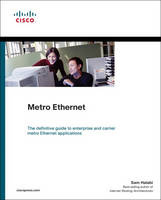
Metro Ethernet (paperback)
Cisco Press (Verlag)
978-1-58705-537-9 (ISBN)
- Titel ist leider vergriffen;
keine Neuauflage - Artikel merken
Discover the latest developments in metro networking, Ethernet, and MPLS services and what they can do for your organization
Learn from the easy-to-read format that enables networking professionals of all levels to understand the concepts
Gain from the experience of industry innovator and best-selling Cisco Press author, Sam Halabi, author of Internet Routing Architectures
Metro networks will emerge as the next area of growth for the networking industry and will represent a major shift in how data services are offered to businesses and residential customers. The metro has always been a challenging environment for delivering data services because it has been built to handle the stringent reliability and availability needs for voice. Carriers will have to go through fundamental shifts to equip the metro for next-generation data services demanded by enterprise customers and consumers. This is not only a technology shift, but also a shift in the operational and business model that will allow the incumbent carriers to transform the metro to offer enhanced data services.
Metro Ethernet from Cisco Press looks at the deployment of metro data services from a holistic view. It describes the current metro, which is based on TDM technology, and discusses the drivers and challenges carriers will face in transforming the metro to address data services.
Metro Ethernet discusses the adoption of metro Ethernet services and how that has led carriers to the delivery of metro data services. With a changing mix of transport technologies, the book then examines current and emerging trends, and delves into the role of virtual private networks (VPN), virtual private local area networks (VLAN), virtual private LAN services (VPLS), traffic engineering, and MPLS and Generalized MPLS (GMPLS).
Sam Halabi is a networking industry veteran with over 16 years of experience. As V. P. of Marketing and Business Development at Extreme Networks, Mr. Halabi was instrumental in leading the development and marketing of emerging technologies such as Enterprise and Carrier Metro Ethernet and Corporate Data Center applications. Prior to Extreme, Mr. Halabi was V. P. of Marketing at Pluris, and held multiple leadership positions at Cisco Systems. Mr. Halabi is the author of Internet Routing Architectures, the first book published by Cisco Press and a best seller in the U.S and international markets. He holds a Masters Degree in Computer Science from San Jose State University.
Introduction.
Goals and Methods. Who Should Read This Book? How This Book Is Organized.
I. ETHERNET: FROM THE LAN TO THE MAN.
1. Introduction to Data in the Metro.
The Metro Network. Ethernet in the Metro. The Early Metro Ethernet Movers.
The BLECs. The Metro Ethernet Carrier. The Greenfield Value Proposition.
The U.S. Incumbent Landscape.
Existing Legacy TDM Infrastructure. Building an All-Ethernet Data Network. Pricing the Service. The Incumbent Regulations.
The International Landscape.
The European Landscape. The Asian Landscape.
A Data View of the Metro. Metro Services.
LAN to Network Resources. Ethernet L2VPN Services.
Ethernet Access and Frame Relay Comparison. Conclusion.
2. Metro Technologies.
Ethernet over SONET/SDH.
The Role of Virtual Concatenation. EOS Used as a Transport Service. EOS with Packet Multiplexing at the Access. EOS with Packet Switching. EOS with Local Switching. EOS Interfaces in the Data Equipment.
Resilient Packet Ring.
RPR Packet Add, Drop, and Forward. RPR Resiliency. RPR Fairness.
Ethernet Transport.
Gigabit Ethernet Hub-and-Spoke Configuration. Gigabit Ethernet Rings.
Conclusion.
3. Metro Ethernet Services.
L2 Switching Basics.
MAC Learning. Flooding. Using Broadcast and Multicast. Expanding the Network with Trunks. VLAN Tagging. The Need for the Spanning Tree Protocol.
Metro Ethernet Services Concepts.
Ethernet Service Definition. Ethernet Service Attributes and Parameters.
Example of an L2 Metro Ethernet Service. Challenges with All-Ethernet Metro Networks.
Restrictions on the Number of Customers. Service Monitoring. Scaling the L2 Backbone. Service Provisioning. Interworking with Legacy Deployments.
Conclusion.
4. Hybrid L2 and L3 IP/MPLS Networks.
Understanding VPN Components. Delivering L3VPNs over IP.
GRE-Based VPNs. MPLS L3VPNs.
L2 Ethernet Services over an IP/MPLS Network.
The Pseudowire Concept. PW Setup Via L2TPv3. Ethernet over MPLS-Draft-Martini. Virtual Private LAN Service.
Conclusion.
II. MPLS: CONTROLLING TRAFFIC OVER YOUR OPTICAL METRO.
5. MPLS Traffic Engineering.
Advantages of Traffic Engineering. Pre-MPLS Traffic Engineering Techniques.
Altering IGP Routing Metrics. Equal-Cost Multipath. Policy-Based Routing. Offline Design of Virtual Circuit Overlays.
MPLS and Traffic Engineering.
Traffic Trunks Versus LSPs. Capabilities of Traffic Engineering over MPLS.
Conclusion.
6. RSVP for Traffic Engineering and Fast Reroute.
Understanding RSVP-TE.
RSVP LSP Tunnels. Label Binding and LSP Tunnel Establishment Via RSVP. Reservation Styles. Details of the PATH Message. Details of the RESV Message.
Understanding MPLS Fast Reroute.
End-to-End Repair. Local Repair.
Conclusion.
7. MPLS Controlling Optical Switches.
Understanding GMPLS. Establishing the Need for GMPLS.
Static and Centralized Provisioning in TDM Networks. The Effect of a Dynamic Provisioning Model.
Signaling Models.
The Overlay Model. The Peer Model. The Augmented Model.
Label Switching in a Nonpacket World.
Label Switching in TDM Networks. Label Switching in WDM Networks.
Conclusion.
8. GMPLS Architecture.
GMPLS Interfaces. Modification of Routing and Signaling.
Enhancements to Routing. Enhancements to Signaling.
Inclusion of Technology-Specific Parameters. Link Management Protocol. GMPLS Protection and Restoration Mechanisms. Summary of Differences Between MPLS and GMPLS. Conclusion.
Appendix: SONET/SDH Basic Framing and Concatenation.
SONET/SDH Frame Formats. SONET/SDH Architecture. SONET/SDH Concatenation. Conclusion.
Glossary.
Index.
| Erscheint lt. Verlag | 12.2.2008 |
|---|---|
| Verlagsort | Indianapolis |
| Sprache | englisch |
| Maße | 100 x 100 mm |
| Gewicht | 100 g |
| Themenwelt | Mathematik / Informatik ► Informatik ► Netzwerke |
| Informatik ► Office Programme ► Outlook | |
| ISBN-10 | 1-58705-537-6 / 1587055376 |
| ISBN-13 | 978-1-58705-537-9 / 9781587055379 |
| Zustand | Neuware |
| Haben Sie eine Frage zum Produkt? |
aus dem Bereich


